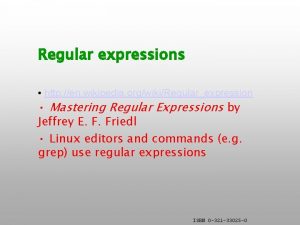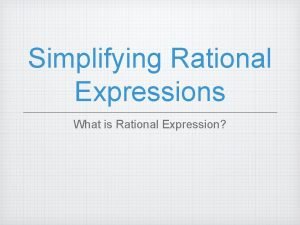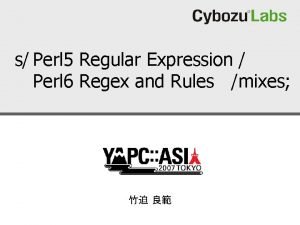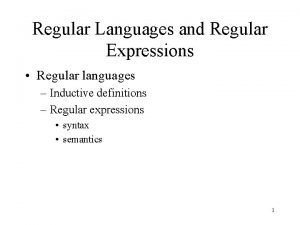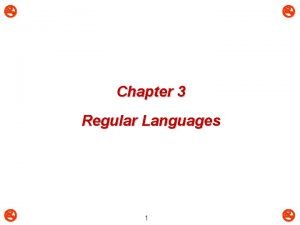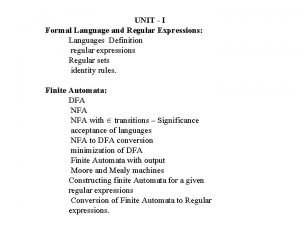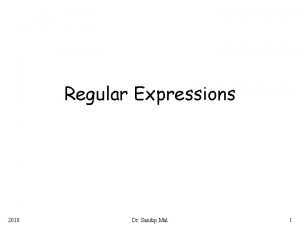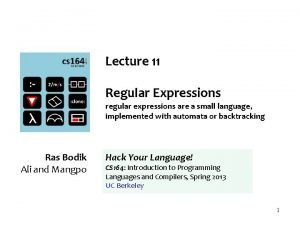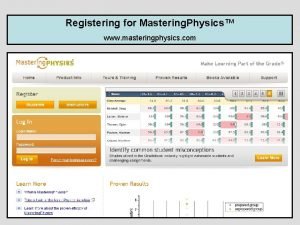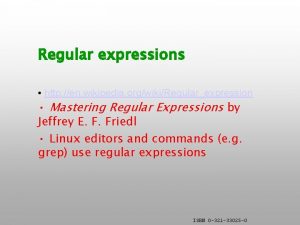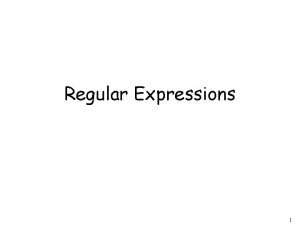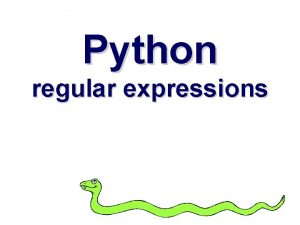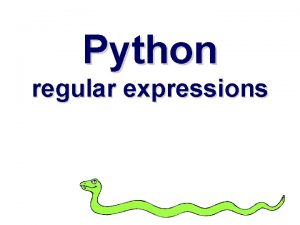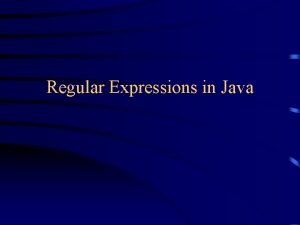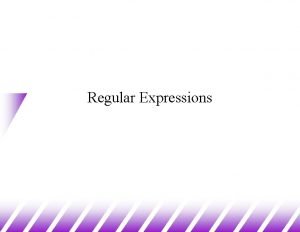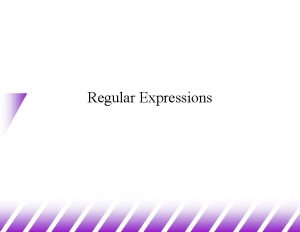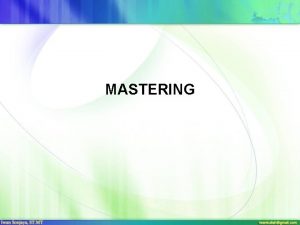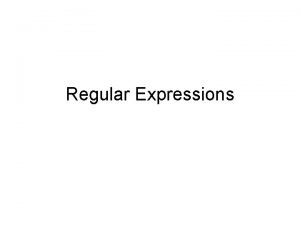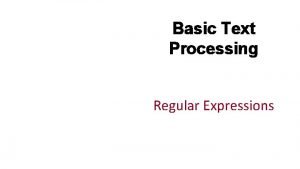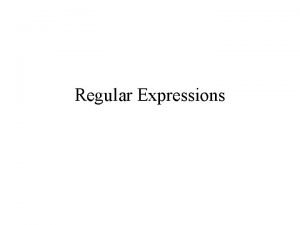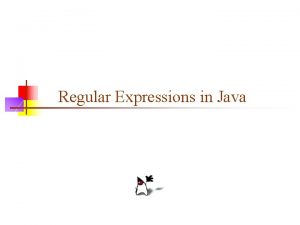Regular expressions http en wikipedia orgwikiRegularexpression Mastering Regular















- Slides: 15

Regular expressions • http: //en. wikipedia. org/wiki/Regular_expression • Mastering Regular Expressions by Jeffrey E. F. Friedl • Linux editors and commands (e. g. grep) use regular expressions ISBN 0 -321 -33025 -0

Language Theory • Chomsky identified four classes of language • Programming languages are described by a context-free grammar • Regular languages are somewhat simpler 2

Regular Grammars • Regular grammars are grammars whose BNF rules are restricted to the form <lhs> -> terminal <non-terminal> • Regular grammars can be represented by finite state automata and by regular expressions 3

Regular Expressions • First described by Stephen Kleene • Used for pattern matching – Unix utilities like grep and awk – built into many scripting languages (e. g. perl) – libraries exist for other languages (Pattern and Matcher classes in Java) • No standard notation – Many languages use Perl Compatible Regular Expressions • Useful for describing things like identifiers and numbers for a programming language 4

Regular Expression Components • Atoms - the characters that can be combined to make the pattern being described • Concatenation - a sequence of atoms • Alternation - a choice between several patterns • Kleene closure (*) - 0 or more occurrences • Positive closure (+) - 1 or more occurrences • nothing ( ) 5

Patterns and Matching • a pattern is generally enclosed between a matched pair of characters, most commonly // – /pattern/ • Languages that support pattern matching may have a match operator 6

Regular Expression Metacharacters • Characters that have a special meaning within a pattern 7

Simple Examples • A single character : /a/ – Matches any string that contains the letter a • A sequence of characters – /ab/ matches any string that contains the letter a followed immediately by the letter b – /bird/ matches any string that contains the word bird – /Regular/ matches any string that contains the word Regular (matches are case-sensitive by default) 8

More Examples • Any character : a. – a followed by any character • A choice of two characters : a | b – a b ac ab bc but not cd ef • Optional repeated character : ab* – a ab abbbb abracadabra • Optional repeated sequence : a(bc)* – a abcbc • At least one of a sequence : ab+ – ab abbbb abracadabra 9

Anchors • Sometimes you want to check for something at the beginning or end of a string – /^The/ matches only if the first three characters in the string are The – /tar$/ matches only if the last three characters of the string are tar – If you need to match the beginning and/or end of a word, you can add a space at the appropriate end 10

Character Classes • You can put a set of characters inside square brackets to create a character class – [abc] means any one of a b or c • A ^ as the first character means any character that isn't in the set – [^abc] means any character except a b or c • You can also specify ranges of characters (based on ASCII codes) – [0 -9] is any digit 11

Perl Compatible Regular Expressions • Use b to specify a word boundary • Named character classes – – d for any digit w for letters, digits and underscores s for whitespace D, W, S exclude the characters in the lower case set • {} after a regular expression can be used to specify a number of repeats • /i at end of pattern means case-insensitive • /s at end of pattern means match newlines –. normally only matches characters other than newlines 12

Regular Expressions for String Manipulation • split( regexp, string) tokenizes a string • s/regexp/replacement/ substitutes for regexp – g at end means do all occurrences • Expression memory allows you to remember what matches parts of pattern in parentheses 13

Regular Expressions in Java • Java has classes for using regular expressions – The String class has a matches method • parameter is a regular expression – The java. util. regex package has classes that can be used for pattern matching operations • Pattern represents regular expressions • Matcher creates an object that performs various pattern matching operations 14

Try these • Give a regular expression to recognize – – java identifiers integer literals a phone number with optional country code number on a license plate • Can you think of any others? 15
 Regular expressions wikipedia
Regular expressions wikipedia Xkcd regexp
Xkcd regexp Site:slidetodoc.com
Site:slidetodoc.com Perl5 正規表現
Perl5 正規表現 Regular language
Regular language Algebraic properties of regular expression
Algebraic properties of regular expression Regular expressions
Regular expressions Primitive regular expressions
Primitive regular expressions Regular expressions
Regular expressions Regular grammars generate regular languages.
Regular grammars generate regular languages. Rurom
Rurom Http wikipedia org
Http wikipedia org Http //mbs.meb.gov.tr/ http //www.alantercihleri.com
Http //mbs.meb.gov.tr/ http //www.alantercihleri.com Http //siat.ung.ac.id atau http //pmb.ung.ac.id
Http //siat.ung.ac.id atau http //pmb.ung.ac.id Www.masteringphysics.com register
Www.masteringphysics.com register Mastering ap environmental science
Mastering ap environmental science
